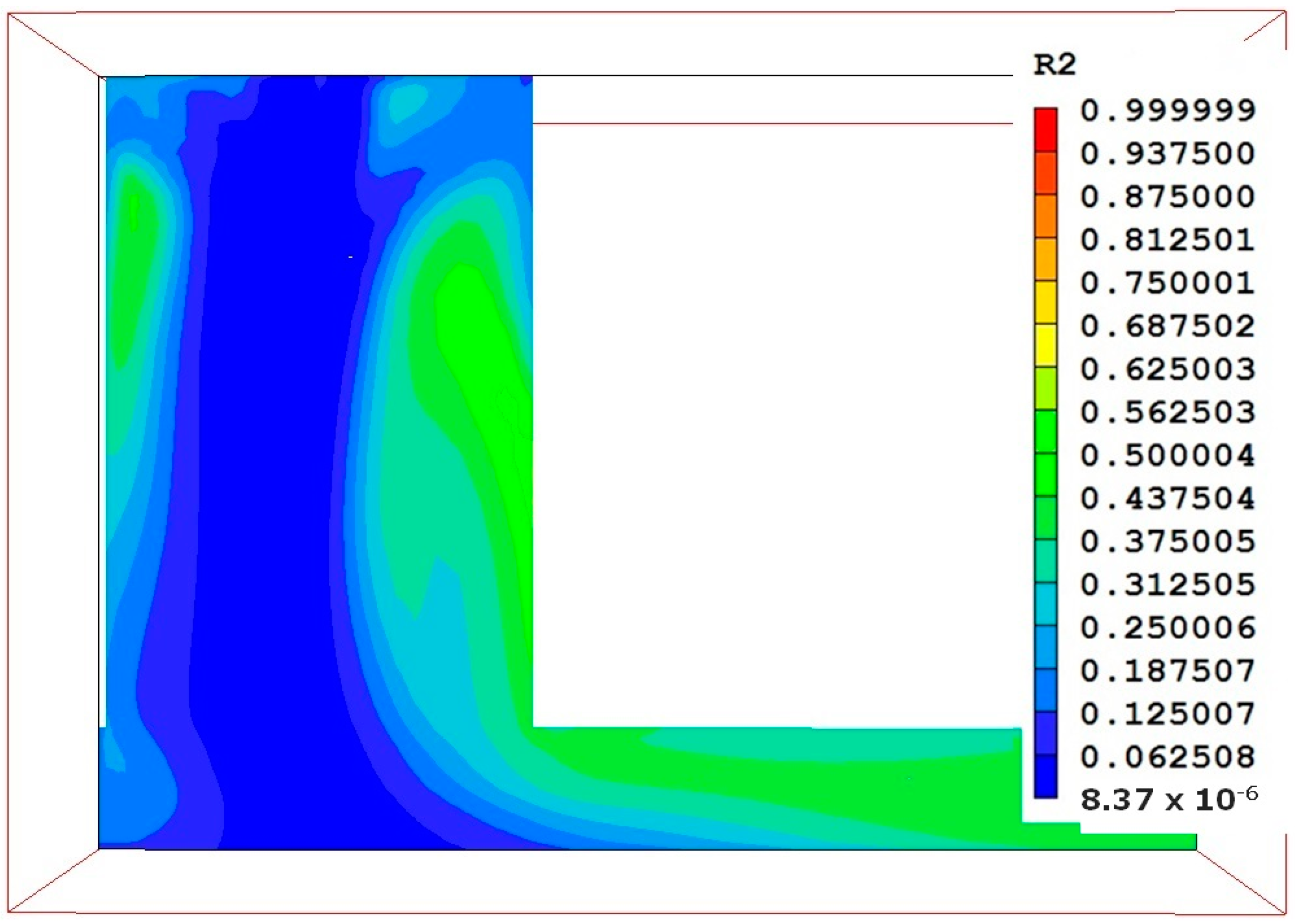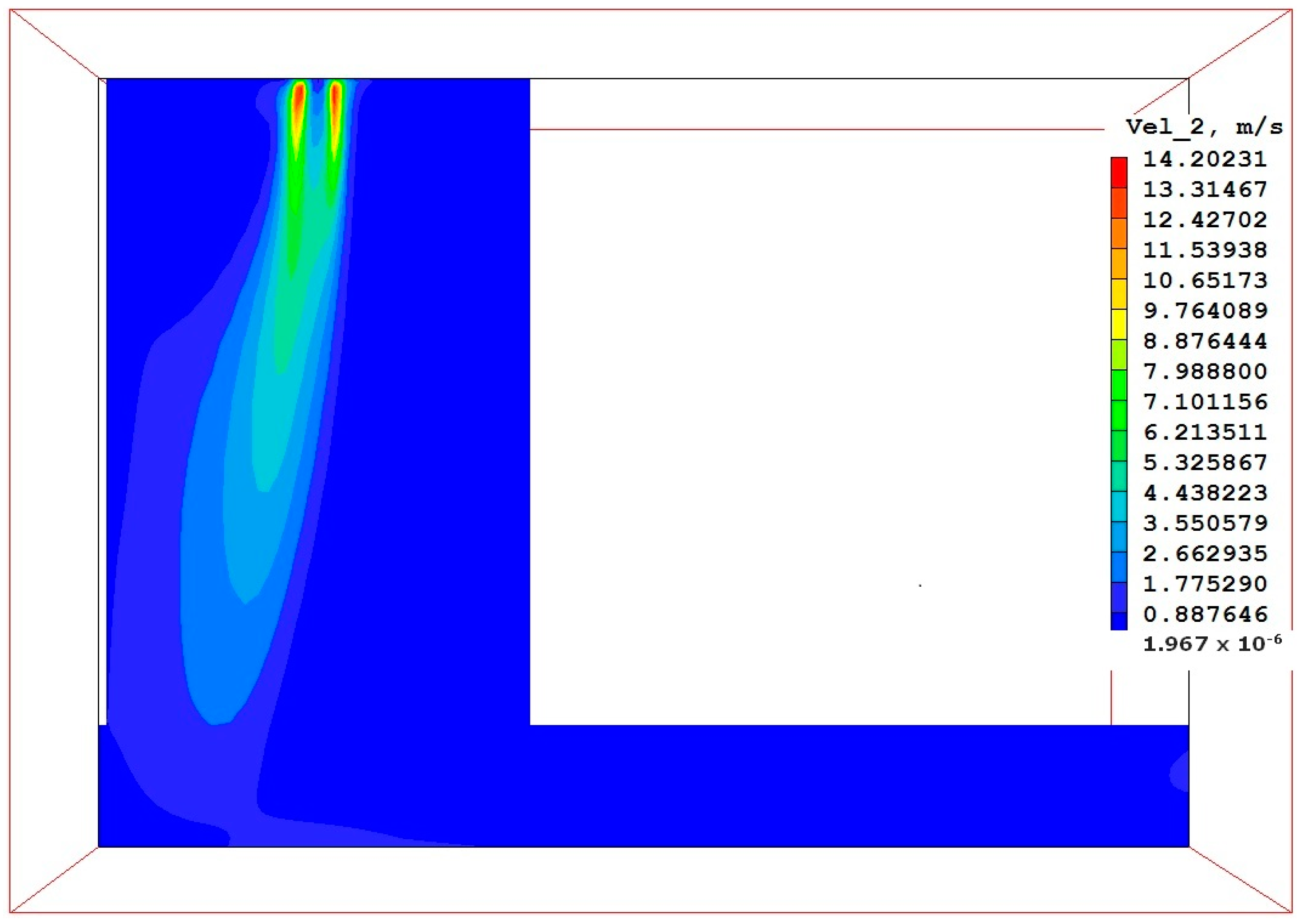Modelling the Movement of Concentrate Particles in a Flash Furnace †
1. Introduction
2. Materials and Methodology
3. Results
Funding
Institutional Review Board Statement
Informed Consent Statement
Data Availability Statement
Conflicts of Interest
References
- Piestrzyński, A. Monograph KGHM Polska Miedź. Wyd; CBPM: Lubin, Polska, 1996; Volume 6, pp. 916–1187. [Google Scholar]
- Miczkowski, Z.; Czernecki, J. Influence of the size of the suspension furnace sludge bath on the amount of dust removed. Ores Metals 2007, 52, 172–175. [Google Scholar]
- Jylhä, P.; Jokilaakso, A. CFD-DEM modelling of matte droplet behaviour in a flash smelting settler. Heliyon 2023, 9, 1–16. [Google Scholar] [CrossRef] [PubMed]
- Wypartowicz, J.; Łędzki, A. Metallurgy of non ferrous metals. Lecture 3, AGH Cracow, Poland, pp. 1–37. Available online: http://home.agh.edu.pl/~zmsz/pl/pliki/mmn/MMN_W03_MIEDZ2.pdf (accessed on 6 March 2014).
- Ma, Z.; Turan, A.; Guo, S. Practical numerical simulations of two-phase flow and heat transfer phenomena in a thermosyphon for design and development. Comput. Sci. 2009, 5544, 665–674. [Google Scholar]
- White, M.; Haywood, D.; Ranasinghe, D.J.; Chen, S. The development and application of a model of copper flash smelting. In Proceedings of the Eleventh International Conference on CFD in the Minerals and Process Industries, Melbourne, Australia, 7–9 December 2015; pp. 1–7. [Google Scholar]
- Miettinen, E. From Experimental Studies to Practical Innovations in Flash Smelting. In Proceedings of the International Process Metallurgy Symposium, Aalto, Finland, 31 October–1 November 2017; pp. 175–186. [Google Scholar]



| Fraction (mm) | Share (%) |
|---|---|
| undersize ≤ 0.071 | 65 |
| >0.071 ÷ ≤0.080 | 9 |
| >0.080 ÷ ≤0.160 | 14 |
Disclaimer/Publisher’s Note: The statements, opinions and data contained in all publications are solely those of the individual author(s) and contributor(s) and not of MDPI and/or the editor(s). MDPI and/or the editor(s) disclaim responsibility for any injury to people or property resulting from any ideas, methods, instructions or products referred to in the content. |
© 2024 by the author. Licensee MDPI, Basel, Switzerland. This article is an open access article distributed under the terms and conditions of the Creative Commons Attribution (CC BY) license (https://creativecommons.org/licenses/by/4.0/).
Share and Cite
Kolczyk, E. Modelling the Movement of Concentrate Particles in a Flash Furnace. Proceedings 2024, 108, 10. https://doi.org/10.3390/proceedings2024108010
Kolczyk E. Modelling the Movement of Concentrate Particles in a Flash Furnace. Proceedings. 2024; 108(1):10. https://doi.org/10.3390/proceedings2024108010
Chicago/Turabian StyleKolczyk, Ewa. 2024. "Modelling the Movement of Concentrate Particles in a Flash Furnace" Proceedings 108, no. 1: 10. https://doi.org/10.3390/proceedings2024108010
APA StyleKolczyk, E. (2024). Modelling the Movement of Concentrate Particles in a Flash Furnace. Proceedings, 108(1), 10. https://doi.org/10.3390/proceedings2024108010





